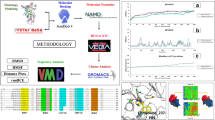Abstract
The current therapy for leishmaniasis is not sufficient and it has two severe drawbacks, host-toxicity and drug resistance. The substantial knowledge of parasite biology is not yet translating into novel drugs for leishmaniasis. Based on this observation, a 3D structural model of Leishmania mitogen-activated protein kinase (MAPK) homologue has been developed, for the first time, by homology modeling and molecular dynamics simulation techniques. The model provided clear insight in its structure features, i.e. ATP binding pocket, phosphorylation lip, and common docking site. Sequence-structure homology recognition identified Leishmania CRK3 (LCRK3) as a distant member of the MAPK superfamily. Multiple sequence alignment and 3D structure model provided the putative ATP binding pocket of Leishmania with respect to human ERK2 and LCRK3. This analysis was helpful in identifying the binding sites and molecular function of the Leishmania specific MAPK homologue. Molecular docking study was performed on this 3D structural model, using different classes of competitive ATP inhibitors of LCRK3, to check whether they exhibit affinity and could be identified as Leishmania MAPK specific inhibitors. It is well known that MAP kinases are extracellular signal regulated kinases ERK1 and ERK2, which are components of the Ras-MAPK signal transduction pathway which is complexed with HDAC4 protein, and their inhibition is of significant therapeutic interest in cancer biology. In order to understand the mechanism of action, docking of indirubin class of molecules to the active site of histone deacetylase 4 (HDAC4) protein is performed, and the binding affinity of the protein-ligand interaction was computed. The new structural insights obtained from this study are all consistent with the available experimental data, suggesting that the homology model of the Leishmania MAPK and its ligand interaction modes are reasonable. Further the comparative molecular electrostatic potential and cavity depth analysis of Leishmania MAPK and human ERK2 suggested several important differences in its ATP binding pocket. Such differences could be exploited in the future for designing Leishmania specific MAPK inhibitors.








Similar content being viewed by others

References
Karioti A, Skaltsa H, Kaiser M, Tasdemir D (2009) Phytomedicine 16:783–787
Sinha PK, Pandey K, Bhattacharya SK (2005) Indian J Med Res 121:407–414
Murray HW, Berman JD, Davies CR et al. (2005) Lancet 366:1561–1577
Vazquez-Pineiro T, Fernandez AJM, Gonzalo LJC et al. (1998) Oral Surg Oral Med Oral Pathol Oral Radiol Endod 86:179–182
de MJA Garcia, Dean FA, Alamillos GF et al. (2007) Med Oral Patol Oral Cir Bucal 12:281–286
Wiese M (1998) EMBO J 17:2619–2628
Chang KP (1983) Int Rev Cytol Suppl 14:267–305
Croft SL, Coombs GH (2003) Trends in Parasit 19:502–508
Murray HW (2004) Exp Rev Anti-infective Therapy 2:279–292
Christopher SP, Kathy S, David H, Lee M et al. (2007) Nat Genet 39:839–847
Gray P, Fred R, Tara BG et al. (2001) Endo Rev 22(2):153–183
Wang Q, Melzer IM, Kruse M et al. (2005) Kinetoplastid Biol Dise 4:6–14
Grant KM, Dunion MH, Yardley V et al. (2004) Antimicrob Agents Chemother 48:3033–3042
Moon MJ, Lee SK, Lee J-W et al. (2006) Bioorg Med Chem 14:237–246
Bardwell AJ, Abdollahi M, Bardwell L (2003) Biochem J 370:1077–1085
Xianbo Z, Voctoria MR, Audrey HW et al. (2000) Proc Natl Acad Sci 97:14329–14333
Sebolt-Leopold JS (2008) Clin Cancer Res 14(12):3651–3666
Friday BB, Adjei AA (2008) Clin Cancer Res 14(2):342–346
McCubrey JA, Milella M, Tafuri A et al. (2008) Curr Opin Investig Drugs 9(6):614–630
Daouti S, Wang H, Li WH et al. (2009) Cancer Res 69(5):1924–1932
Tai K, Fowler P, Mokrab Y, Stansfeld P, Sansom MS (2008) Methods Cell Biol 90:233–265
William BH, Bisson WG, Schubiger PA, Scapozza L (2008) J Mol Model 14:891–899
Pietra F (2009) J Chem Inf Model 49:972–977
Ohori M, Kinoshita T, Okubo M et al. (2005) Biochem Biophys Res Commun 336:357–363
Marti-Renom MA, Stuart AC, Fiser A (2000) Annu Rev Biophys Biomol Struct 29:291–325
Laskowski RA, MacArthur MW, Moss DS et al. (1993) J Appl Crystallogr 26:283–291
Colovos C, Yeates TO (1993) Protein Sci 2:1511–1519
Sippl MJ (1993) Proteins: Struct Funct Genet 17:355–362
Brooks BR, Bruccoleri RE, Olafson BD et al. (1983) J Comput Chem 4:187–217
DISCOVERY STUDIO, Accelrys, San Diego, CA, USA
MacKerell AD Jr, Bashford D, Bellott M et al. (1998) J Phys Chem B 102:3586–3616
Jean-Paul R, Giovanni C, Herman JCB (1977) J Comput Phys 23:327–341
SYBYL software package, Tripos Inc, St Louis, USA
Bhattacharjee AK, Karle JM (1999) Chem Res Toxicol 12:422–428
Morris GM, Goodsell DS, Halliday RS et al. (1998) J Comput Chem 19:1639–1662
Ohori M (2008) Drug News Perspect 21(5):245–250
Waskiewicz AJ, Cooper JA (1995) Curr Opin Cell Biol 7:798–805
Xiao Z, Hao Y, Liu B, Qian L (2002) Leuk Lymphoma 43:1763–1768
Hoessel R, Leclerc S, Endicott JA et al. (1999) Nat Cell Biol 1:60–67
Marko D, Schatzle S, Friedel A et al. (2001) Br J Cancer 84:283–289
Acknowledgments
This research was supported by grants from the Ministry of Chemicals and Fertilizers, Govt. of India, India. CGM also acknowledges the Department of Biotechnology (IFD-Dy. No.102/ IFD/SAN/ 884/2006-2009) New Delhi, India for partial financial support of this work. PS is recipient of Senior Research Fellowship from Department of Biotechnology, India.
Author information
Authors and Affiliations
Corresponding author
Supplementary material
Below is the link to the electronic supplementary material.
Supplementary material Figure 1s
Errat plot of Leishmania MAPK model (DOC 74 kb)
Supplementary materia Figure 2s
Scatter plot of actual in vitro activities (ED50) versus the binding energy computed using AutoDock software (DOC 35 kb)
Rights and permissions
About this article
Cite this article
Awale, M., Kumar, V., Saravanan, P. et al. Homology modeling and atomic level binding study of Leishmania MAPK with inhibitors. J Mol Model 16, 475–488 (2010). https://doi.org/10.1007/s00894-009-0565-3
Received:
Accepted:
Published:
Issue Date:
DOI: https://doi.org/10.1007/s00894-009-0565-3



